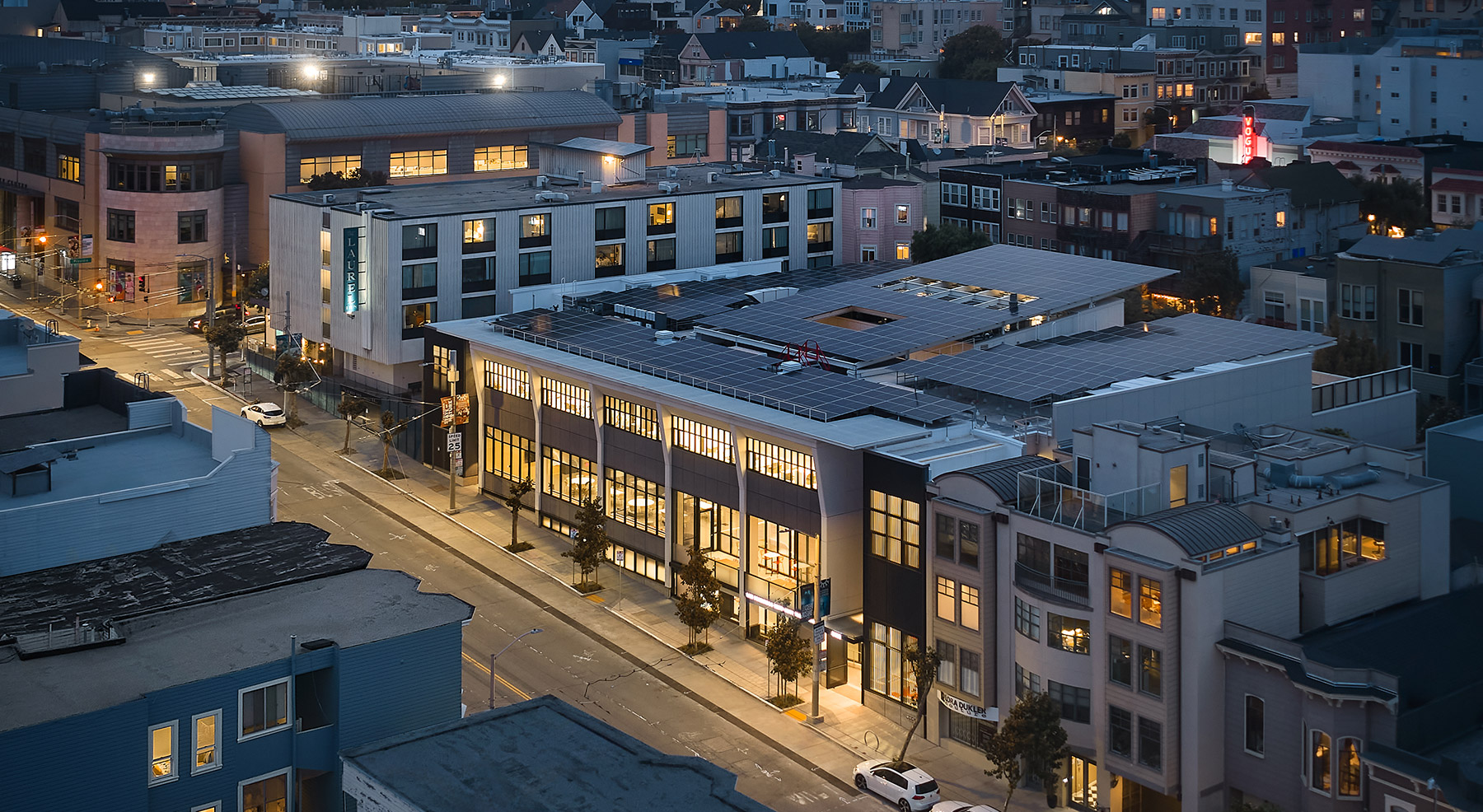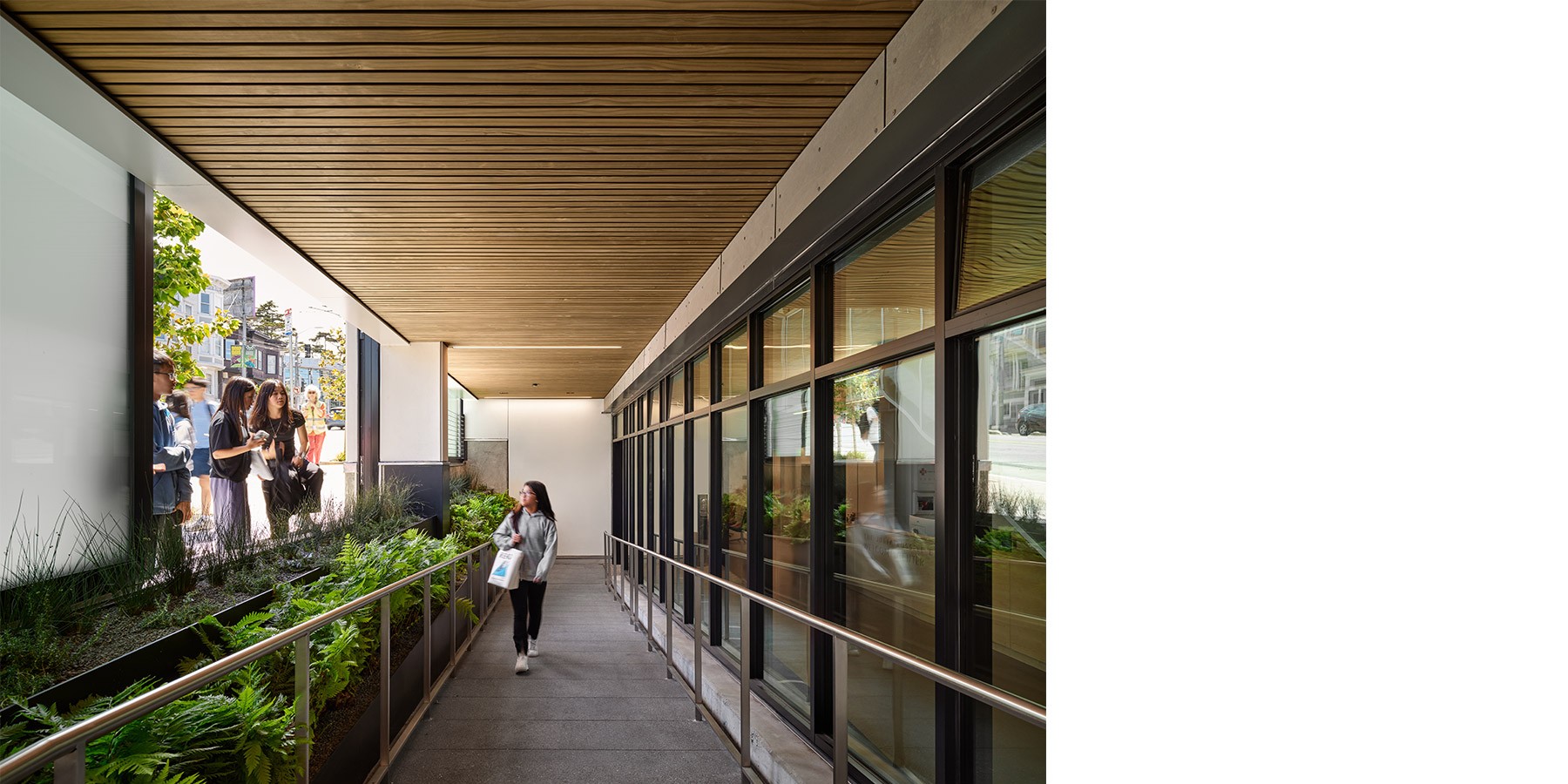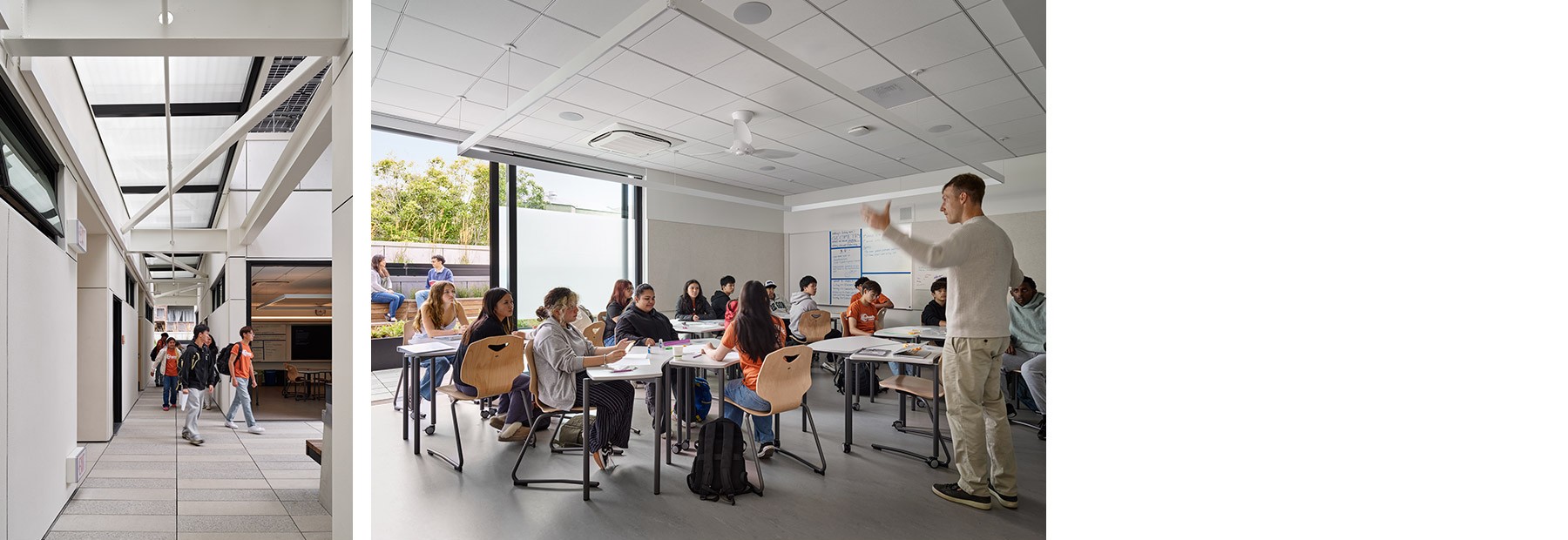San Francisco University High School Raises the Bar for Climate Positive Educational Design

San Francisco University High School, one of the city’s leading independent schools, was founded in 1973 to be a model of “excellence and equity.” Nearly 60 percent of its students identify as people of color, and 20 percent of the student body receives financial aid.
When school leadership decided to construct its first ground-up building, they envisioned more than a state-of-the-art science and athletics facility. They wanted to create a new “front door” for the entire school that both serves and expresses the school’s core mission: “...to engage our community of diverse voices in a transformational experience that embraces the spirited pursuit of learning and empowers purpose larger than self.”

Unlocking Campus Potential
Over the decades, University High School (UHS) expanded from one to four buildings dispersed across the Pacific Heights neighborhood. Widely respected for its excellent academics, the school also prides itself on supporting student athletics as an integral element of nurturing whole student wellness. Planning for the new building began with an assessment of the programmatic distribution of the entire school. As part of an extensive community engagement process, LMSA staff held workshops, attended classes, and had lunch with students to determine a more appropriate disbursement of common gathering and dining spaces, classrooms, and offices that could serve the school for the next fifty years This new layout distributed school uses more equitably across the five campuses, providing greater programmatic flexibility, , improved student access to services, faculty and staff, and a wider variety of places to congregate and collaborate.

Uncovering the Past
The California Street site, like the rest of current-day San Francisco, is part of the traditional territory of the Ramaytush Ohlone people. In the 1880’s, the California Street Railroad Company, one of several companies that established cable-car service in San Francisco, extended the California St. line through this block and built a brick garage here. The cable cars no longer come this far, but when the site was excavated, a remaining section of the 1905 garage foundation was revealed. Most recently, the site was occupied by a one-story strip mall and its parking lot. Built in the 1940s, the low-density complex originally housed a Safeway, followed by a succession of smaller retail and office tenants. When other reminders of the past were discovered during construction, such as vintage glass bottles, the contractor, Truebeck, thoughtfully collected them for the school to display in the new entry lobby.

Form Follows Function
Within this tight and steeply sloping infill site with a 40-foot height limit, the California St. campus had to fit a competition-size gymnasium/assembly space, classrooms, and a large student commons. As the largest space, the gym is the organizing element, and the other spaces are efficiently deployed around it, showcasing what is possible in ground-up construction. The steel plate girders that support the classrooms above the gym also create the façade of the 47,400-square-foot building. The 25-feet-wide structural bays match the scale, proportion, and rhythm of the adjoining residential buildings, effectively weaving the large building into the urban fabric. In the back, the design team leveraged the necessary rear setback to create an outdoor, rooftop gathering space shaded by solar panels.


Welcoming All to UHS
The sidewalk entrance signals that this is a special place well before you arrive at the front door. Reflecting UHS’s culture of equity and inclusion, the building welcomes everyone - regardless of age or ability - down a landscaped, sun-filled ramp to enter the building. The gradual entry, lined with plants, provides a tranquil transition between the city and the school environment, taking students and visitors from the bustling street to the more tranquil interior of the school. A double height reception space leads to the second floor student commons which overlooks both the street and gymnasium/assembly space below. The commons extends to an exterior “sun porch” on the second level that remains open to the street during school hours; after hours, sliding glass doors enclose the building.

A Vessel for the School Community
While the typical high school gym is a windowless box, they don’t have to be that way. LMSA designed the space to function both as a multi-sport gymnasium and a 600-seat venue where the whole school can gather together. A window wall visually connects the gym with the second-floor commons and the cityscape beyond and fills it with natural light, creating a unique space that balances athletic function with community gathering, urban connection, transparency, and structural expression.

Modeling a Zero Carbon Future
In keeping with the founding vision of a school "in and of the city,” the California Street campus connects students, faculty, and staff with their environment. The building emphasizes natural ventilation and natural light, which helps regulate occupants’ circadian rhythms while reducing energy demands. In addition to operable windows and skylights, hallways are open-air. Solar panels supply 100% of the all-electric building’s power needs, resulting in net-zero energy use. To reduce embodied carbon, the concrete in the building is a special mix that cuts the amount of carbon-intensive cement by nearly 50 percent. A large underground cistern captures rainwater to reuse it for irrigation. With all these features, the building is slated to reach LEED Platinum certification, the highest rating possible.

One Size Should Not Fit All
In the double-height lobby, a warm and inviting reception area greets students and prospective families. Designed to welcome all, LMSA was careful to design gathering spaces that cater to students who are more extroverted as well as those who are more introverted. A long bench in the lobby is very public, while other nooks offer more privacy.

Freedom of Choice
The new building was an opportunity for UHS to add inclusive restrooms. Giving everyone a choice, the lower level has gendered restrooms, while the upper floors have all-gender restrooms. The all-gender restrooms feature floor-to-ceiling partitions for privacy, and supergraphics identifying the features of each stall. The entry doors can remain open during school hours to provide a view into the sink and mirror area to help ensure student safety.

Connections to Nature
Open space is rare in a dense urban setting, so LMSA looked for every opportunity to provide it. In the teachers’ courtyard on the rooftop, a planter supports a mini-ecosystem of plants and vines; skylights are raised above the ground plane so that they can double as backrests for benches. At the rear of the building, the back roof terrace is a place for gathering and learning, featuring more planters and deep benches that invite reclining.

Building as Teacher
The building teaches about living and learning in a low-carbon world, modeling a hopeful, sustainable future. The design integrates cost-effective design solutions that provide practical and poetic connections between people and the natural world. How the building breathes, manages water, and structurally supports itself are all on display. For example, an interactive display in the lobby tracks energy usage, electricity generated by the solar array, and potable water use in real time, helping students and staff see how daily use affects these precious resources. Linked indoor and outdoor learning spaces create an “ecology of learning” where students practice sustainability, conduct environmental studies, and debate solutions to a broad range of environmental challenges.
LMSA has designed over 20 K-12 educational facilities during our more than 25 years in practice. We appreciate the opportunity to collaborate with the University High School and many other institutions. We rely on a wide range of trusted partners (see below) to help create these complex, program-rich projects.
Project Credits:
Architect/Interiors: LMSA
Development Consultant: Equity Community Builders
Landscape Architect: In Situ
Civil Engineer: Luk and Associates
Structural Engineer: Forell/Elsesser
MEP and Energy Modeling: PAE
Acoustic Consultant: Salter
Food Service: Patrick Stein and Associates
Lab Consultant: HERA
AV/Low Voltage: Smith, Fause, & McDonald. Inc.
Contractor: Truebeck Construction